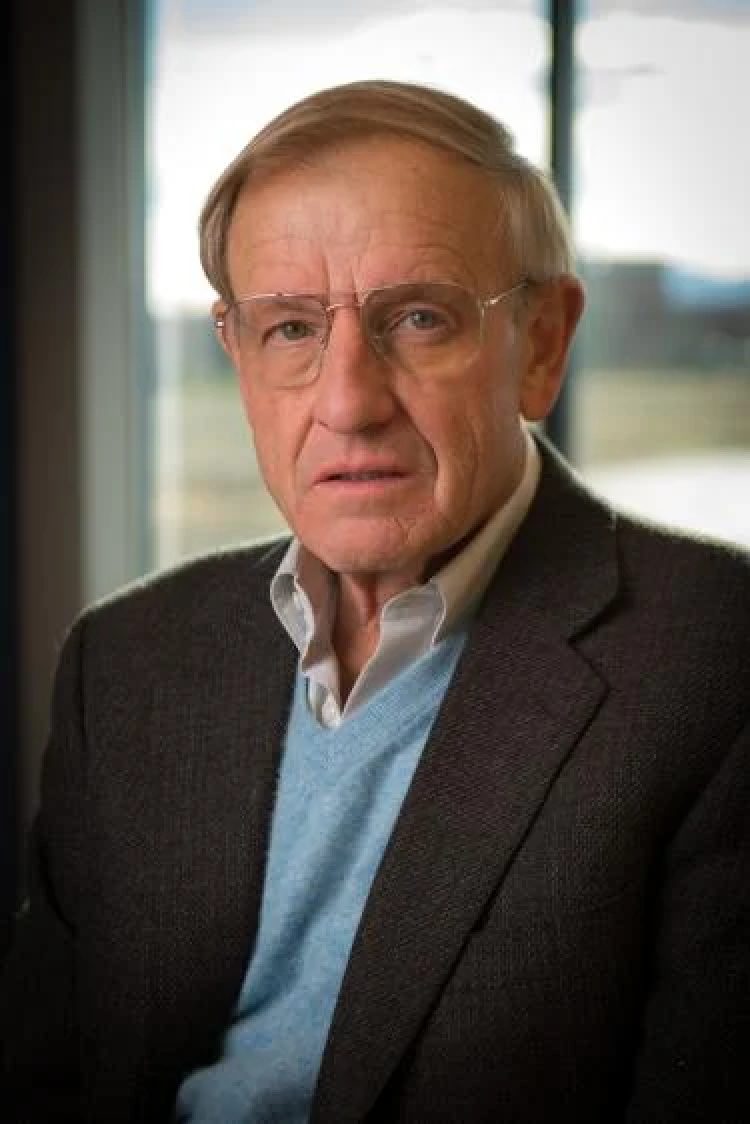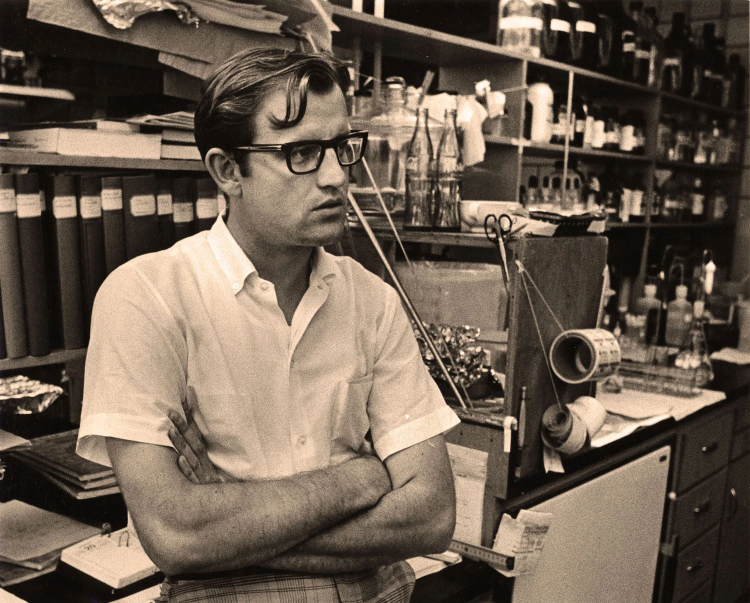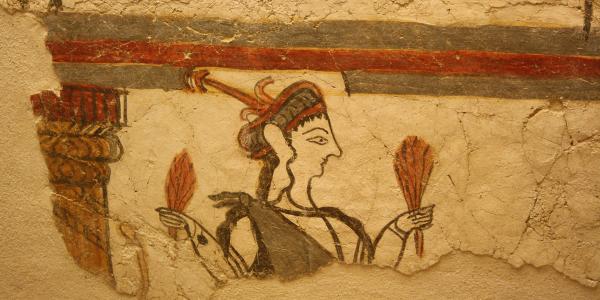The $400,000 award recognizes the far-reaching medical impact of Caruthers’ development, in the early 1980s, of an efficient and fast method to synthesize nucleic acids
Marvin H. Caruthers explains the importance of developing technology for synthesizing DNA.
Marvin H. Caruthers, distinguished professor of chemistry and biochemistry at the University of Colorado Boulder, has won the inaugural Richard N. Merkin Prize in Biomedical Technology for developing an efficient, automated technology for synthesizing DNA.
The chemical reactions that Caruthers discovered in the early 1980s, which accurately and quickly assemble nucleotides into strands of DNA, provided an essential element in the development of modern molecular medicine, according to the Merkin Prize selection committee. Today, scientists use these reactions to produce customizable DNA and RNA molecules that enable genetic sequencing, drug and vaccine development, pathogen tests, cancer diagnostics, and many aspects of basic biomedical research.
“I am honored to acknowledge the incredible and transformative impact of Dr. Caruthers’ technology on human health over the last four decades,” said Dr. Richard Merkin, founder and CEO of Heritage Provider Network, one of the country’s largest physician-founded and physician-owned integrated health care systems. “He deserves our support and recognition. I hope this prize not only raises awareness of this work but underscores and encourages others to realize the broader importance of developing new scientific technologies to transform health care.”
The Merkin Prize, which recognizes novel technologies that have improved human health, carries a $400,000 cash award. The prize was created by the Merkin Family Foundation and is administered by the Broad Institute of MIT and Harvard.
Caruthers will be honored in a prize ceremony held this fall.
“I’m really very happy that this work is being recognized,” Caruthers said. “It’s been amazing to see the technology have such widespread use over the years.”
“The method developed by Dr. Marvin Caruthers was truly revolutionary. It exemplifies how a powerful technology can promote discovery and improve medical care. There are now whole fields of biology, medicine and public health that one cannot imagine practicing without his methods for synthesis of polynucleotides,” said Dr. Harold Varmus, chair of the Merkin Prize selection committee. Varmus is the Lewis Thomas University Professor at Weill Cornell Medicine, a senior associate at the New York Genome Center and a recipient of the Nobel Prize in Physiology or Medicine for his work on the origins of cancer.
More than 50 technologies and scores of scientists from around the globe who invented them were nominated for the 2023 Merkin Prize. Those nominations were evaluated by the selection committee, composed of eight scientific leaders from academia and industry in the U.S. and Europe.
Paving the Way for a Genetics Revolution
Today, scientists routinely manipulate genetic material to study human health and diagnose and treat disease. They sequence genes to diagnose inherited conditions and cancers, synthesize DNA and RNA strands by the millions to detect pathogens, manufacture drugs and edit the sequences of genes as potential therapy. Just a few decades ago, before the synthetic methodologies developed in the Caruthers laboratory, none of this was possible.

Caruthers is a CU Boulder distinguished professor of biochemistry and internationally recognized expert in chemical biology and genetics.
Born in 1940 in Des Moines, Iowa, Caruthers became enamored with science in the third grade, when his parents gave him a chemistry set. The color-changing liquids and exploding mixtures of chemicals fascinated him.
He went on to study chemistry at Iowa State University before joining the lab of Robert Letsinger at Northwestern University in 1963, a decade after the discovery of DNA’s double helix structure.
During his graduate education at Northwestern, Caruthers learned how to assemble nucleotides—the building blocks of DNA and RNA—into short sequences using methods Letsinger pioneered. But the approach was slow and inefficient.
“To make one little piece of synthetic DNA a few nucleotides long could take two months,” Caruthers recalled.
While at Northwestern, he assembled five nucleotides into a strand of DNA, representing a major breakthrough at the time. He then became a postdoctoral fellow in the University of Wisconsin lab of Gobind Khorana, who shared the Nobel Prize in Physiology or Medicine for discovering how the order of nucleotides in DNA encodes proteins. There, Caruthers became interested in how DNA was regulated and what its many sequences meant. Studying these problems was hard, though, without a way to build new pieces of DNA.
By the time Caruthers joined the chemistry and biochemistry department at the University of Colorado Boulder in 1973, he had set a goal to improve DNA synthesis.
“It was clear to me at the time that none of the current technologies were really very good for general, everyday use by most biologists,” he said. “But most scientists in the biological and biochemistry communities couldn’t care less.”
At conferences and in hallways, colleagues frequently questioned why he wanted to develop new methods to synthesize DNA; most did not see any benefit, Caruthers said.
Over the coming years, with significant contributions from graduate student Mark Matteucci and postdoctoral fellow Serge Beaucage, Caruthers’ lab tackled the problem. They first probed how to provide structural support for fragile, lengthening strands of DNA, and discovered that a highly porous silica glass known as “controlled pore glass” worked far better than the polystyrene that researchers had been using.
Colleagues frequently questioned why develop new methods to synthesize DNA; most did not see any benefit. Suddenly, in less than a day, you could make a piece of synthetic DNA that would have taken months using older methods."
Then, the team developed a chemical method to protect nucleotides from undergoing unwanted reactions during DNA synthesis — a major reason DNA synthesis had been so inefficient. Caruthers’ group discovered how to create protected “deoxynucleoside phosphoramidites” that didn’t undergo the unwanted reactions. This made the synthesis reaction far more efficient. A series of chemical reactions could be carried out again and again, with each new iteration successively adding a new nucleotide to a growing strand of DNA in a matter of seconds.
“Suddenly, in less than a day, you could make a piece of synthetic DNA that would have taken months using older methods,” Caruthers said.
A Lasting Impact
With the new technique, the Caruthers lab could rapidly synthesize strands of up to 30 nucleotides. In 1981, Caruthers and Matteucci described the controlled pore glass support in Journal of the American Chemical Society and Caruthers and Beaucage published the new approach for DNA synthesis in Tetrahedron Letters. Other scientists quickly began using the methods, and soon adapted the approach for synthesizing the other important polynucleotide, RNA.
At the same time, Caruthers imagined the technique could become even more widespread with machines to automate the repetitive process. He teamed up with world-leading protein scientist and systems biology pioneer Leroy Hood, then at the California Institute of Technology, to develop instruments for DNA and protein synthesis and protein sequencing, described in a seminal 1984 Nature paper. Together, the pair launched a company—Applied Biosystems—that would produce both machines.
“I knew from day one that if people had to make their own reagents and chemically synthesize DNA in their own labs, it was never going to take off,” Caruthers said. “If they could instead order DNA from a supplier, or have a really good machine to automate it, that could appeal to biologists.”

The Caruthers' lab is desinged to generate and manipulate DNA. Photo courtesy of Caruthers.
Caruthers’ foresight paid off. Such machines now produce strands of DNA hundreds of nucleotides long; DNA microchips can produce millions of these sequences at a time.
Today, scientists frequently synthesize short stretches of DNA to act as “primers,” binding to genes of interest for the purpose of sequencing those genes or making new copies of them. Caruthers’ technology was critical for developing polymerase chain reaction (PCR), which rapidly amplifies DNA or RNA so it can be detected or studied in greater detail. This technology also underlies many new diagnostic methods, including tests for COVID-19, for selection of cancer therapies and for noninvasive prenatal screening for fetal abnormalities.
Longer synthetic DNA and RNA molecules also are critical for modern biologic drugs. These strands of genetic material carry the instructions for cells to produce antigens and therapeutic proteins, with the potential to prevent or treat infectious and metabolic diseases and cancers.
“The ability to synthesize genetic information has changed the face of medicine,” said Varmus. “Synthesis of DNA and RNA is not only used directly for making diagnostics and therapies; its effects are magnified when you consider all the medical advances that have come out of research dependent on gene sequencing.”
Caruthers is a recipient of the National Medal of Science and an elected member of the National Academy of Sciences, the American Academy of Arts & Sciences, the National Academy of Inventors, and the National Inventors Hall of Fame. In addition to his role at Applied Biosystems, he is a co-founder of companies including Amgen, Array BioPharma, miRagen Therapeutics, SynGenis and ProGenis.
Nominations for the 2024 Merkin Prize will open in September 2023. Visit merkinprize.org for more information.



